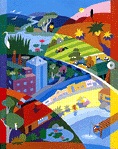
Warning: Signs of Change

"Extinctions are happening today at a greater rate
than any time in the past 65 million years."
Professor Harry Recher,Edith Cowan University

Warning: Signs of Change

"Extinctions are happening today at a greater rate
than any time in the past 65 million years."
Professor Harry Recher,Edith Cowan University
| Australian biologist Professor Harry Recher has warned
that many Australian bird species will probably be extinct within 50 years if rapid
habitat loss continues. We have all heard reports of the disappearance of some frog
species. Freshwater fish such as Murray Cod are also suffering. Off the coast some eastern
fisheries have virtually collapsed - all signs that our biodiversity is suffering from
human disturbance. Things are also turning bad for Australian Honeyeaters, whose numbers have been dropping for some years. These birds depend on coastal heathlands in winter but move inland to woodlands in summer. Although coastal heathlands still flourish, the widespread clearing of inland woodlands is now threatening their survival. The warning signs are there that Australia's biodiversity is feeling the strain. Some of the casualties are: Society is placing increasing pressure on the biodiversity that maintains ou lifestyles. This section of my environment web site is based upon a booklet produced by the Department of the Environment and Heritage, Environment Australia. This material can be freely reproduced for non-commercial purposes provided Environment Australia is acknowledged. Their logo appears at the bottom of this page. |
Now take a tour of my Biodiversity Web.
![]() 20 Ways to Protect Biodiversity
20 Ways to Protect Biodiversity
![]() In the Backyard and Beyond
In the Backyard and Beyond
![]() Food, Health, Farms
Food, Health, Farms
![]() On Holiday and on the Water
On Holiday and on the Water
![]() Links and Resources
Links and Resources
![]() Biodiversity Home
Page
Biodiversity Home
Page
![]() Back to the Environment Site Map
Back to the Environment Site Map
![]() E-mail me
E-mail me
Biodiversity material from:
